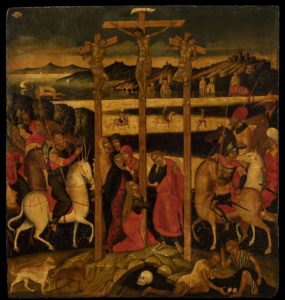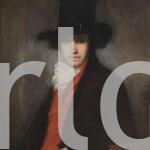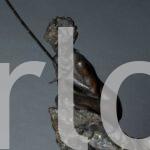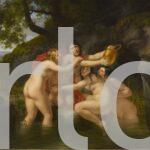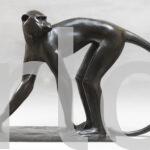| NOT AVAILABLE
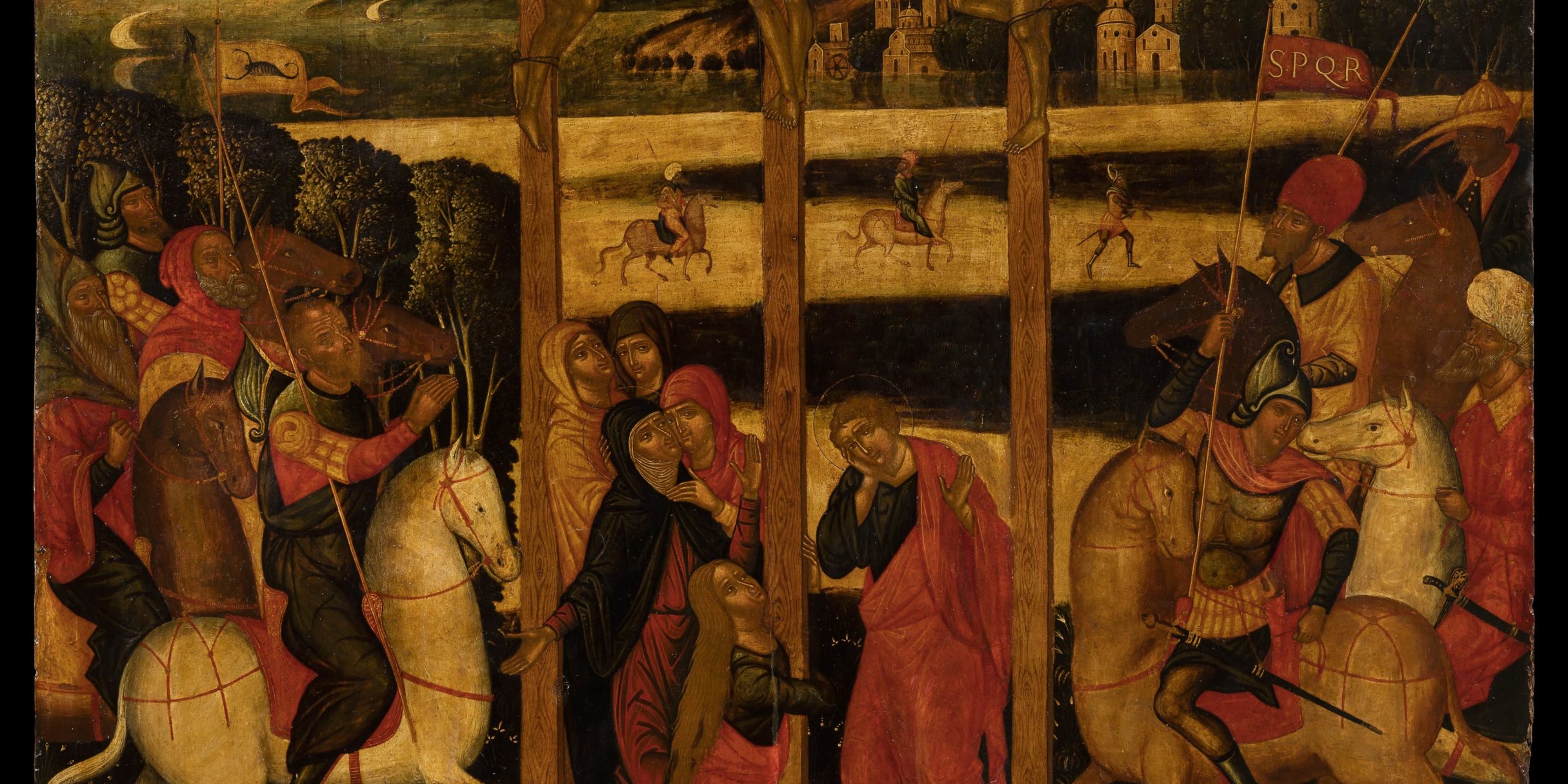
ZUAN PERMENIATIS
(Crete 1501 – Venice (?) 1550)
Crucifixion
1520-30 ca.
Egg tempera on panel, 99.5 x 92.5 cm (39.2 x 36.4 in)
Provenance: Padua, private collection
The painting by the Cretan artist, active in Venice in the first half of the XVI century, shows the Crucifixion of Christ and the two thieves on Calvary with groups of saints and spectators.
The composition is divided into four parallel sections. From the bottom, in the foreground to the right there are two male figures playing dice for Christ’s robe. On the dark cloak, two large dice both show the number one, as written in the Apocrypha, pointed out by one of the figures. To the left there are two greyhounds, one brown and one white that are walking towards the crosses, following a feline. In the centre of the scene Adam’s skull lies in a small cave that symbolizes Calvary.
On the next layer the painting’s main narrative is played out, which is to say the Crucifixion. The centre of the scene is dominated by the three wooden crosses; the robbers on the side crosses are tied with dark cord rather than crucified, while on the centre cross Christ is crucified with nails. The Lord’s head is decorated with a crown of gold and has a slight halo. His cross bears the inscription I.N.R.I., while to the right and left of the upper shaft are the abbreviations IC – XC. Three groups of people are distributed around the three crosses. Beneath the central cross Magdalene kneels, holding the vertical plank, John the Apostle stands to the right and the Madonna with three veiled women to the left. To the right hand side of the crosses are four horsemen: a Roman soldier holding the standard with the lettering S.P.Q. R. and three old oriental men, a Mamluk with a white turban, an Ottoman with a red hat carrying a lance and an African with a Byzantine hat. To the left of the crosses are another four horsemen watching the scene in similar postures: a Roman soldier holding a standard with the symbol of the scorpion, another holding a lance and the remaining, two old men wearing hoods. The background of the second level is a flowered field stretching around the high land of Calvary.
The third compositional strip opens behind a curtain of trees to the left of the painting. It is a steppe or sand plain with three figures: two oriental horsemen, a Mamluk with a white turban and an Ottoman with red hat (perhaps the same as the main scene), who follow a Roman foot soldier; all three carrying lances.
The fourth level is taken up by the landscape that frames the entire religious scene. There is a partial marine view, with sailing ships and gulfs with hills edged with buildings in Romanesque and Renaissance style architecture among which can be seen castles, churches, towers and a watermill.
The painting’s iconography precisely follows the compositional system of the second half of the fifteenth century. A famous point of reference relevant here is the Crucifixion that Andrea Mantegna carried out between 1457-1459 for the altarpiece at San Zeno, today conserved at the Musée du Louvre in Paris, which follows the same line as that of Antonello da Messina, in the various versions of the Crucifixion made in the latter half of the fifteenth century. More precisely, the panel follows the canons of quattrocento composition both in form and content: the landscape includes peaked hills, often with water and contemporary settlements, the people, besides the holy figures, are Orientals and Roman soldiers, almost always from the Scorpion legion, the thieves are never crucified with nails on the wooden planks of the cross but tied, while Christ dominates on the central cross with the majestic position of his open arms. Soldiers are often present at the scene, playing dice for the holy robes. An elegiac sense always pervades the scene, in contrast to the tragic quality of the event. The whole is almost taken over by nature and the humanized landscape. The setting and costumes, horses and arms give the composition a theatrical feel, and the protagonists always wear restrained, measured expressions, even in the case of the Madonna, Magdalene and John who have lost their loved one. The same iconography continues and evolves in the fifteen hundreds starting from Floriano Ferramola at San Salvatore in Brescia, carried out in the same years as our panel, up to the very famous painting by Tintoretto at the Scuola Grande di San Rocco. Unlike the examples from the cinquecento, this panel presents a notable archaism and does not develop themes but crystallizes itself in more primitive modes. Furthermore this is characteristic of Cretan painters of Byzantine tradition who worked in Italy: conservative, archaic with western elements more or less adapted to the Byzantine style. This is the case of Andrea Pavias, Andrea Ritzos, Angelo Bizamano, Nicola Zafuris and Zuan Permeniatis.
The pictorial quality of the panel is refined and elegant. It derives from the great Cretan tradition with the characteristics of defined drawing and crystalline colour as seen in Pavias. The brushstrokes are often blurred and set up with base colour, the lights and features are made in long subtle brushstrokes, as in Zafuris. The landscape is precise and detailed, the natural elements and architecture painted with thin soft brushstrokes. The fleshtones are soft and gentle, with no exaggeration. The chiaroscuro on the bodies and faces are very soft and similar to the yellow ochre base. The hair is worked with very delicate strokes, for instance the beards, reproducing natural hairstyle moved by the wind. Unlike the fleshtones, the clothes do not show western softness but maintain a certain rigidity in the outlined edges. The condition of the painting is exceptional, with only very slight losses in the uppermost and lower parts.
The Cretan painter Zuan Permeniatis, (1501-1550) worked in Venice where he had the opportunity to see western elements and assimilate them in his art, contributing to the bilingual style that began in the fifteenth century and continued to the twentieth. The artist was particularly attracted by landscape and its use in the Renaissance, and was fascinated by perspective, which he always endeavoured to employ. In this way he created Italian scenes with Byzantine people that speak a mixed dialect. It would be interesting to note the extent to which Permeniatis used aesthetic styles and compare him to bilingual painters such as Michele Damasceno, Georgia Klontzas, Emmanuel Lampardos and Domenico Theotokopulos. Most of all with the last of these, the famous El Greco, who was active 50 years later, for a comparison is fruitful regarding the use that the two make of perspective and in the complexity of the scenic narrative that they develop. Without a doubt Permeniatis produced in Venice works that satisfied the tastes of the devout Orthodox and Catholics.
The Crucifixion panel shows the artist’s most strongly individual identity linking it to famous examples. Works of Permeniatis are rare and mainly found in Italian and Greek museums, churches and private collections. Taking into consideration two examples that are thematically analogous allows us to make comparisons to demonstrate the attribution to the Cretan painter. These are the Adoration of the Magi and the Madonna Enthroned with St Sebastian and St Rocco. The first is conserved at the Benaki Museum in Athens while the second is in a private collection (sold by the Swiss auction house Schuler Auktionen).
The landscape is absolutely alike in all three cases, both in stylistic concept and in formal subject. Equally the representation of nature and architecture in the three paintings is identical. Besides the sky and water, the hills are precisely comparable and the trees adopt the same archetype: thick green foliage with light touching the leaves and slender trunks with multiple divisions at the base. In the same way, they all share anthropic elements: the architecture is almost identical and shows single elements in common (Romanesque churches with square plan bell tower, the dome of the Orthodox church, towers, mill and fortresses). The coherence of the artist’s manner of representing ships is impressive, with their very full triangular sails moving parallel to the lower levels. Returning to natural elements, the flowered fields are similar in all three paintings, using the same floral type and working technique: thin green brushstrokes with touches of light and white dots for the flowers. Equally the treatment of rocky areas is alike: rounded, soft shapes with dense thin peaks, and openings to semicircular caves (Calvary and the nativity cave). In these cases the animals are painted in the same way too, especially animals of the same species (dogs and horses), which appear similar both in form and in their decoration. The same restricted range of motifs and forms is also adopted in the case of the people. The figures of the Mamluk, Ottoman and African in the Crucifixion are identical to those of the Adoration (where they appear twice). Facial features show many similarities in all the paintings’ figures: the almond-shaped eyes, straight noses and the mouths. And there are many shared elements in the case of naked bodies. Comparing the bodies on the crosses to that of St Sebastian (besides the natural difference deriving from altered scales) coherent elements can be seen in the spiral navel, the thin double fold between the second band of abdominals and the stomach, the numerous slender ribs and the vertical lines of light on the sternum. Hands, feet and clothes are alike in the three works, there are differences in the hair, colours and details of clothes and slight expressions of the faces, but the shapes remain the same. The complexity of the artist’s compositions is unusual and is more noticeable in the large panels that portray scenes than in his portraits of saints. This concerted composition is based on his experience in central Italy, but is the fruit of a conservative tradition by a post Byzantine.
Moreover this is the feature that makes the Cretan painter unique, belonging to an extremely conservative tradition but open to changes in style and revolutionary experiences such as the Italian Renaissance.
The egg tempera painting portraying the Crucifixion should be considered rare and therefore an exceptional example of the work of the Cretan, Zuan Permeniatis. Its imposing scale, the condition and the compositional richness of the painting define it as a rare and important example of Veneto-Cretan art from the first half of the XVI century. The quality of the painter has located his works in museums such as Correr and the Galleries of the Venice Academy. His role in post Byzantine history of art is unquestionably significant and the Crucifixion should be viewed and assessed in this light.
Dr losif Hadjikyriakos
The Carlo Virgilio & C. Gallery searches for works by Permeniatis Zuan (1501-1550)
To buy or sell works by Permeniatis Zuan (1501-1550) or to request free estimates and evaluations
mail info@carlovirgilio.co.uk
whatsapp +39 3382427650
